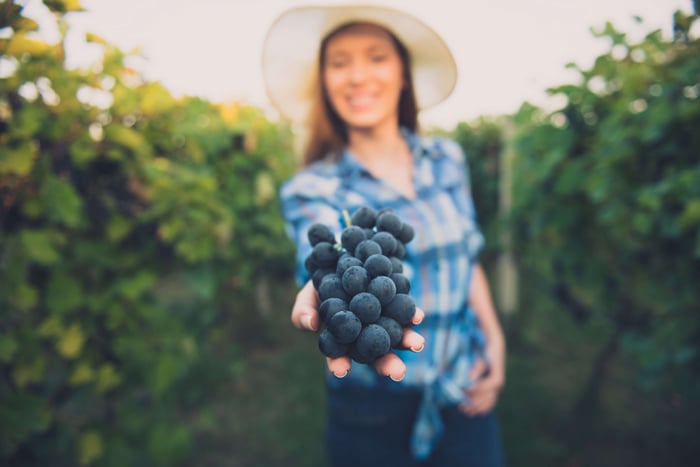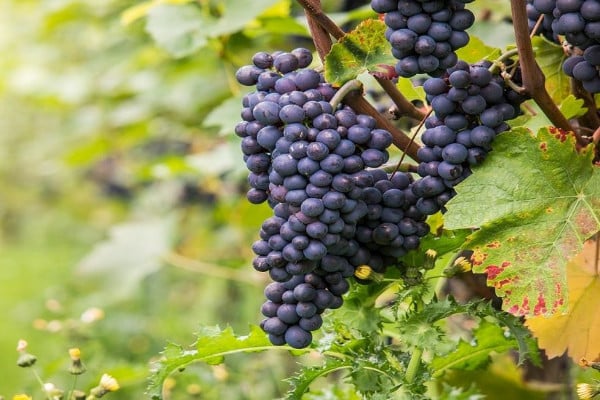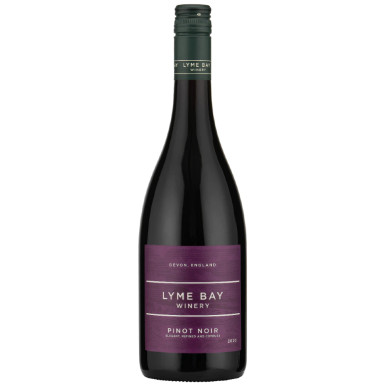
6 early ripening grapes you need to try
Early ripening grapes are particularly important in cool and continental climate regions like the UK and Alsace. If you live in England, you may have noticed vineyards preparing – or indeed already starting – to pick their early ripening grapes.
Where the growing season is shorter or more unpredictable no winemaker wants their crop to be damaged by adverse weather. Because they are picked earlier, early ripening grapes maintain higher acidity and lower sugar levels, leading to fresh wines with a more moderate alcohol content.
So, what are the world's most popular wines made from early ripening grapes?
Pinot Noir
Pinot Noir is one of the most famous early ripening grapes, celebrated for its delicate flavours of raspberry, cherry and hibiscus with undertones of mushroom and clove. Because it is a thin-skinned variety, it is sensitive to temperature changes and therefore prefers cooler climates, where it can ripen slowly but early enough to avoid rain and frost.
 Pinot Noir Grapes
Pinot Noir Grapes
The most reputed region for Pinot Noir is Burgundy, where it thrives in the cool, continental climate. In recent years, wines made from the grape in Essex’s Crouch Valley, are gaining status thanks to a similar micro climate.
Other New World regions to explore for Pinot Noir are Willamette Valley in the US state of Oregon, and Central Otago in New Zealand, which produces a more vibrant, fruit-forward style.
Wine to try: Lyme Bay Pinot Noir
With intense red fruit and smoky, vanilla undertones, Lyme Bay Pinot Noir is a great example of what can be achieved from Pinot Noir grapes grown near Essex’s River Crouch.
Lyme Bay Pinot Noir 2021, Devon

£29.50
This English red wine is the colour of black cherries with lighter edge tones. The nose has intense, red fruit combined with smoky, vanilla oak...… read more
Pinot Gris
Sharing its genetic origins with Pinot Noir, Pinot Gris, unsurprisingly, also thrives in cooler climates and tends to ripen relatively early in the growing season. It often develops complex stone fruit flavours of pear and peach and has citrus and floral notes, often with a distinctive minerality.
 Pinot Gris Grapes
Pinot Gris Grapes
In the Italian regions of Veneto and Friuli, where Pinot Gris is known as Pinot Grigio, the grapes are picked really early to make light, crisp and refreshing wines with citrus and green apple notes. Oregon’s Willamette Valley, is also producing some interesting examples of zesty Pinot Gris but with a fruit-driven profile leaning more towards stone fruits.
In Alsace, Pinot Gris is one of the four noble varieties and often produces fuller-bodied, richer styles of Pinot Gris with ripe fruit flavours and spice. Producers in the UK are also starting to plant more Pinot Gris and are experimenting with styles – from creamy, refined and rounded to quirkier skin-contact versions.
Wine to try: Sharpham "Little Bee" Pinot Gris
Another British wine, this time from Devon, this wild ferment has spent three weeks on its skins before fermentation and is fresh with fennel and grapefruit followed by juicy nectarine and more sour stone fruit flavours.
Sharpham Pinot Gris Wild Ferment "Little Bee" 2022, Devon

£20.65
This is an exciting depature from the normal style of Sharpham wine. It is the brainchild of the young and dynamic assitant winemaker, Charlie Brown....… read more
Chardonnay
Sadly, Chardonnay still has its haters – ABCers (Anything But Chardonnay) who have been influenced by the buttery, overly-oaked versions that dominated the market in the 1990s.
Now t Chardonnay Grapeshe most widely planted grape in the world, the versatile Chardonnay grape can adapt to a wide range of climates and consequently produces a variety of styles of white wine. In cooler regions, it produces wines with crisp acidity and subtle flavours, while in warmer areas, it can develop fuller, riper fruit profiles.
Chardonnay Grapeshe most widely planted grape in the world, the versatile Chardonnay grape can adapt to a wide range of climates and consequently produces a variety of styles of white wine. In cooler regions, it produces wines with crisp acidity and subtle flavours, while in warmer areas, it can develop fuller, riper fruit profiles.
Picked early in regions such as Burgundy, Champagne, England and Tasmania, it produces mineral-driven sparkling and still wines that highlight the grape’s natural acidity and can achieve excellent aging potential
Wine to try: Famille Gueguen Côtes Salines
From 30-year-old Bourgogne vines located just beyond the boundary of the Chablis appellation, in the village of Préhy, this is a crisp and steely chardonnay great minerality thanks to the unique terroir of Côtes Salines.
Famille Gueguen, Côtes Salines 2023, Burgundy

£17.75
Céline and Frédéric Gueguen both come from winemaking families (Céline is the daughter of Jean-Marc Brocard) and established their 36 hectare estate in 2013. Their...… read more
Gamay
Gamay is the star of Beaujolais, a region just south of Burgundy, and is known for its early ripening grapes and vibrant fruit flavours. This variety produces light, refreshing, fruit-forward wines that are often enjoyed young, particularly in the case of Beaujolais Nouveau, where carbonic maceration is used to soften tannins and Kirsch flavours.
 Gamay Grapes
Gamay Grapes
It is also grown in France’s Loire Valley – growers in parts of Touraine produce bright and aromatic reds from the grape. A few producers in England are also experimenting with the Gamay, including Biddenden Vineyards in Kent, which planted it as far back as the 1980s.
Wine to try: Beaujolais Nouveau
Expect bubble-gum, raspberries, cherries and fresh, vibrant juicy fun when Domaine Bel Avenir’s Beaujolais Nouveau 2024 arrives this 21st November. Be sure to pre-order a bottle or two now.
Beaujolais Nouveau 2025, Domaine Bel Avenir

£14.00
It’s that time again Le Beaujolais Nouveau est Arrivé! Beaujolais Nouveau Day is always the third Thursday in November. Once again we have partnered with...… read more
Riesling
Known for retaining high acidity, even in warmer conditions, Riesling is an ideal choice for winemakers in both cool and moderate climates and produces aromatic white wines that range from bone dry to lusciously sweet.
 Riesling Grapes
Riesling Grapes
The Mosel in Germany produces some of the world’s most prestigious Rieslings, with delicate flavours and high acidity enabling the wines to age and develop those notable esoteric petrol characteristics.
Alsace is another famous Riesling region but here the wines are typically bone dry, still retain that steely acidity and flinty aromas but are usually fuller bodied with more concentrated flavours and alcohol.
In the new world, Australia’s Clare and Eden Valleys produce some excellent dry Rieslings with intense citrus, lime and tropical flavours, while examples from New Zealand can be sweet or dry.
Wine to try: Smalltown Vineyards Rag and Bone Riesling
With fruit sourced from a single vineyard, high up on the Eastern side of Eden Valley, this zippy wine is bursting with zesty lime and floral characters with a crispy mineral finish.
Smalltown Vineyards "Rag & Bone" Riesling 2020, Eden Valley

£14.85
The nose on this Australian white wine classically expresses the vineyard it's like a fresh lime crushed gently over minerals, literally lime on the rocks....… read more
Müller-Thurgau
A crossing, created by Swiss botanist Hermann Müller, of Riesling with Madeleine Royale, Müller-Thurgau ripens earlier than Riesling and can achieve full maturity in cooler climates or regions with shorter growing seasons.
 Müller-Thurgau Grapes
Müller-Thurgau Grapes
It tends to be lower in acidity than Riesling, meaning the wines are softer and more approachable, although still fresh. Sadly, the grape’s reputation has been somewhat tarnished by its historical association with cheap German wines, such as Liebfraumilch.
Like Riesling, it is widely planted in Baden, Rheinhessen and the Mosel, where it produces light, fruity wines. Austria, where it is known as Rivaner, also has a high population of Müller-Thurgau, producing easy-drinking styles, and it is also grown in higher altitude vineyards in the Valais region of Switzerland.
Wine to try: Blackbook Winery Mix Up Vol IV
Despite a lot of Müller-Thurgau plantings here in England being replaced with Champagne varieties, some winemakers, like Sergio Verrillo at Blackbook, are vying to make the style more fashionable again. Here he has blended it with Rechsteiner to add more flavour and texture. Vanilla, ginger, stone fruit and a slight herbaceous edge make this a great foodie wine, particularly with East Asian flavours.
Blackbook Winery The Mix-Up Volume IV 2021, London

£22.50
A new wine and new blend for 2021, and like previous iterations very different from its siblings . This white blend was made from two...… read more

.jpg)


